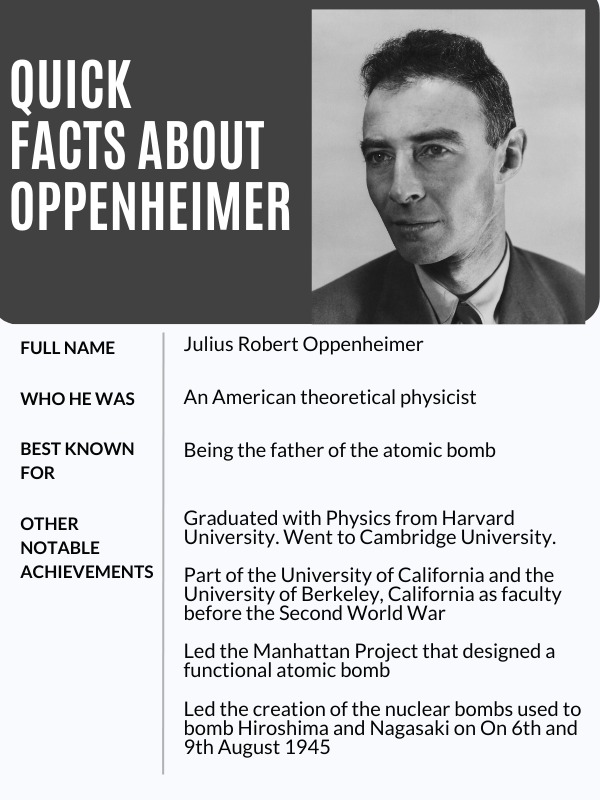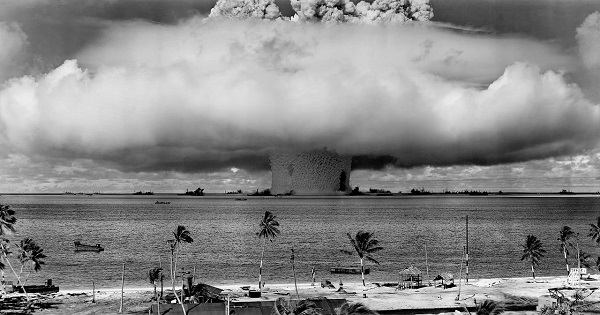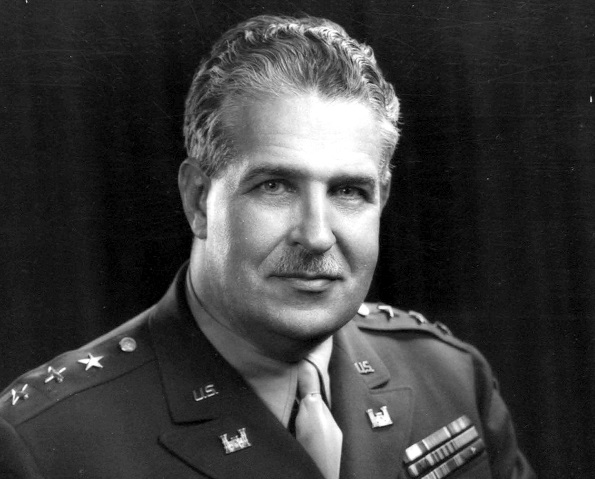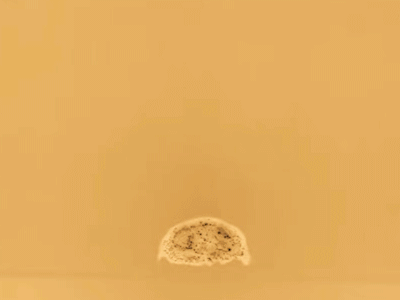Who was J. Robert Oppenheimer?
Written by Sthitee Mohanty, senior writer.
Robert Oppenheimer was an American theoretical physicist, whose full name was Julius Robert Oppenheimer.
Written by Sthitee Mohanty, senior writer
TW: This article is about war and bombs – not recommended for children under 13 years of age
If you are wondering who was Robert Oppenheimer, then this is where you’ll get all the information about him.
You may have watched Christopher Nolan’s movie named Oppenheimer. This film was named after a person named Robert Oppenheimer.
Who was Robert Oppenheimer?

Robert Oppenheimer was an American theoretical physicist, whose full name was Julius Robert Oppenheimer. Although he is famously known as the father of the atomic bomb, he was much more than that. He worked as a professor of Theoretical Physics at the University of California, Berkeley (USA). More on him below
His role in the Second World War

Oppenheimer was the director of a weapon’s laboratory in Los Angeles (USA) during the Second World War. He was the head of a secret weapon manufacturing department that developed atomic bombs.
The name of the project that developed the atomic bomb during the second World War was the Manhattan Project – the aim of this project was to develop usable nuclear weapons.
This was a time when Hitler had become very powerful the world needed to fight him. The Manhattan Project was America’s response to the hidden weapons of Hitler’s army. The funding (money) for this came from the United States with help from the United Kingdom and Canada.
What bombs did Oppenheimer develop?

He led the project that developed two bombs, named Fat Man and Little Boy. These were dropped by the U.S.A. on two Javanese cites known as Hiroshima and Nagasaki to stop the Second World War.
Worst bombings

These bombs between 129,000 and 226,000 people in the two towns – most of the people who died were civilians. To this day, these bombings remain the only use of nuclear weapons in a war.
The United States claimed that the use of such weapons was necessary to stop the war. That may or not be true, but the human massacre these bombs caused haunted Oppenheimer till the end of his life.
Oppenheimer’s personal life and academic journey
On 22 April 1904, Julius Robert Oppenheimer was born to J. S. Oppenheimer and Ella Friedman an immigrant German couple who were Jewish but did not follow the traditions of the religion.
He grew up in New York City, attending Ethical Culture Society School till 1922.
In 1922, Oppenheimer entered Harvard to study chemistry. His first academic choice was not physics but chemistry. He switched to physics later and graduated in 1925. He then went to work under J.J. Thomson at Cambridge University.
Did you know that J.J. Thomson is credited with the discovery of the electron in an atom? You may remember his plum pudding model of an atom!
Oppenheimer received his Ph.D. when he was 22 at the University of Göttingen, Germany. While working on separate research projects, he returned to Harvard to study mathematical physics and then attended the California Institute of Technology.
In 1940, he married Katherine “Kitty” Puening, an American botanist. He has two children with her, Peter and Katherine.
Oppenheimer remains an important figure in the field of quantum physics and nuclear physics.
Oppenheimer’s scientific discoveries
Many call Oppenheimer the founding father of the American school of theoretical physics.
After developing the Born-Oppenheimer approximation equation (an equation that argued for a motion of nuclear particles that was different from the motion of electrical particles), he taught students at both the University of California Berkeley and the California Institute of Technology. He spent almost 13 years there teaching!
His interests lay in the fields of nuclear physics, cosmic rays, spectroscopy, astrophysics, quantum tunneling, and quantum field theory.
Did you know that the papers Oppenheimer wrote In the 1930s, suggested the existence of what we now call black holes?
The beginning of World War II saw Oppenheimer’s rising involvement in nuclear weaponization. In 1942, Oppenheimer was appointed the scientific director of the Manhattan Project by General Leslie Groves.
Who was General Leslie Groves?

Lieutenant General Leslie R. Groves Jr was an army engineer corps officer of the U.S.A. Army. From 1940-1942, Groves saw the overall engineering activities of the US Army, even the building of the Pentagon.
As the US government had growing fears about Germany’s development and use of nuclear weapons under Adolf Hitler’s command, the Manhattan Project was begun on 13 August 1942.
This was right after Japan bombed Pearl Harbor – many believed that this bombing caused the United States to take revenge on Japan by bombing Hiroshima-Nagasaki.
Groves was made director of the Manhattan Project in 1942. He then proceeded to approach Oppenheimer for this project.
What was the Manhattan Project?
The Manhattan Project was U.S.A.’s response to the hidden weapons of Hitler’s army. This research project was funded by the United States with help from the United Kingdom and Canada.
The main aim of this project was to develop usable nuclear weapons for the Second World War.
Did you know that Albert Einstein signed a letter written by physicist Leo Szilard warning the world of uranium weapons with great power?
This letter was sent to the then-US President Franklin D. Roosevelt who put together the Advisory Committee on Uranium to investigate the destructive properties of uranium.
At its peak, the project employed approximately 129,000 people. The workforce consisted of military personnel, construction workers, scientists, and plant operators.
Under the Manhattan Project, Oppenheimer oversaw the construction of laboratories at Los Alamos, New Mexico, U.S.A. He then went on to bring in the best physicists in the world to work on creating an atomic bomb. In 1945, the laboratory boasted 6000 personnel.
So what happened at the Los Alamos Laboratory?
The Los Alamos Laboratory was a secret research laboratory operated by the University of California under a contractual obligation to the US military – Oppenheimer simply headed the research division there.
The laboratory had code names too! It was called Site Y or the Hill.
Did you know that Oppenheimer called the group of scientists working in Los Alamos the Luminaries?
The physical landscape of Los Alamos was suitable for the testing of atomic bombs. The region was isolated from the human population and an abandoned school acted as housing for the people involved in the project.
Thus the Los Alamos laboratory become the development site of implosion-type bombs that used plutonium as the explosive material.
Dangers of Plutonium
- Nearly all plutonium is man-made through nuclear reactions – thus, it is radioactive material
- Plutonium takes a long time to break down physically – it will radioactively poison the environment for longer
- If inhaled, plutonium causes lung scarring and prolonged inhalation can cause lung cancer
After much deliberation, the Christy Gadget was developed by Oppenheimer and his team. It was this Gadget that was detonated near Alamogordo, New Mexico, creating the world’s first nuclear explosion on 16 July 1945. Oppenheimer had named the Alamogordo testing site Trinity.
The explosion caused the formation of a new mineral called trinitite by melting the site’s sand.
The Trinity test of the Manhattan Project was the first detonation of a nuclear weapon – on 16th July 1945

It is said that on witnessing this nuclear detonation, Oppenheimer, quoting the Bhagavad Gita, said, “Now I am become Death, the destroyer of worlds.” There is a YouTube video of this very moment too (note: there are some differences of opinion about the exact translation – in some translations of the supposed text of the Gits, instead of “death”, the word “time” is used)
The bombs of Hiroshima and Nagasaki
The bombs dropped on Hiroshima and Nagasaki were developed in Los Alamos by Oppenheimer’s team. Scientist Robert Serber named them Fat Man and Little Boy.
Little Boy was dropped on Hiroshima on 6 August 1945. Fat Man was dropped on Nagasaki on 9 August 1945.
| Name of bomb | Little Boy | Fat Man |
| Type | Gun-type fission weapon | Implosion type |
| Nuclear material used | Uranium | Plutonium |
| Casualties | 146,000 | 80,000 |
Some claim that these bombings were necessary to end the war. Yet records show that the scientists of the Manhattan Project were against the second bombing of Nagasaki carried out by the U.S. Army.
What happened to Oppenheimer after the war ended?
In 1946, Oppenheimer was awarded the Medal for Merit by President Harry S. Truman for his role as the Director of the Los Alamos laboratory.
When appointed as the Chairman of the General Advisory Committee to the Atomic Energy Commission (AEC) in the U.S.A., Oppenheimer was openly against the use of nuclear weapons and the development of the hydrogen bomb.
The U.S. Government investigated him, because of his communist ideological leanings. In the end, his security clearance was removed by the government.
He was still awarded the prestigious Enrico Fermi Award by President Lyndon B. Johnson at the Atomic Energy Commission’s 1963 celebrations.
Oppenheimer went on to serve as Director of Princeton’s Institute for Advanced Study till 1966. He, unfortunately, passed away on 18 February 1967 from throat cancer.
Timeline
1927 | Joined the University of California, Berkeley, and Caltech as a faculty member |
| January-June 1942 | Organized fast neutron theoretical physics program at Berkeley and Chicago Met Lab |
| July-September 1942 | Studied bomb design principles in a group |
| 29 September 1942 | Developed designs for an atomic bomb |
| 15 October 1942 | Asked by Groves to be Director |
| 19 October 1942 | Appointment approved by US military |
| 16 November 1942 | Selected Los Alamos as Site Y |
| 1943 | The director of Los Alamo’s term starts |
| 16 July 1945 | The Trinity test was successful in New Mexico |
| 16 October 1945 | Resigns as Los Alamos director |
| 1946 | Awarded Medal for Merit by President Truman |
| 1947 | Became director of the Institute for Advanced Study, Princeton, New Jersey |
| 29 June 1954 | Oppenheimer’s security clearance revoked by US Atomic Energy Commission |
Is the movie Oppenheimer a true representation of his life and events?
Christopher Nolan’s Oppenheimer is based on Kai Bird and Martin J. Sherwin’s Pulitzer Prize-winning biography American Prometheus: The Triumph and Tragedy of J. Robert Oppenheimer.
Actor Cillian Murphy plays the role of J. Robert Oppenheimer.
We do not know if Oppenheimer regretted creating the atomic bomb. Yet, he was extremely vocal about the dangers of nuclear weaponization and radioactive poisoning after the Second World War ended.

Better Your Child’s G.K. In 3 Minutes – Get This Free Newsletter
Get fun facts, simple and easy news, quizzes, and lots of other interesting things to read in your mailbox – for free! It’s what we call GK-on-the-go!
I Kid You Not now has a large readership across India and also parts of the world. If you want to write for us, you can submit your story here. You can also apply to become a news anchor. Apply here





Comments